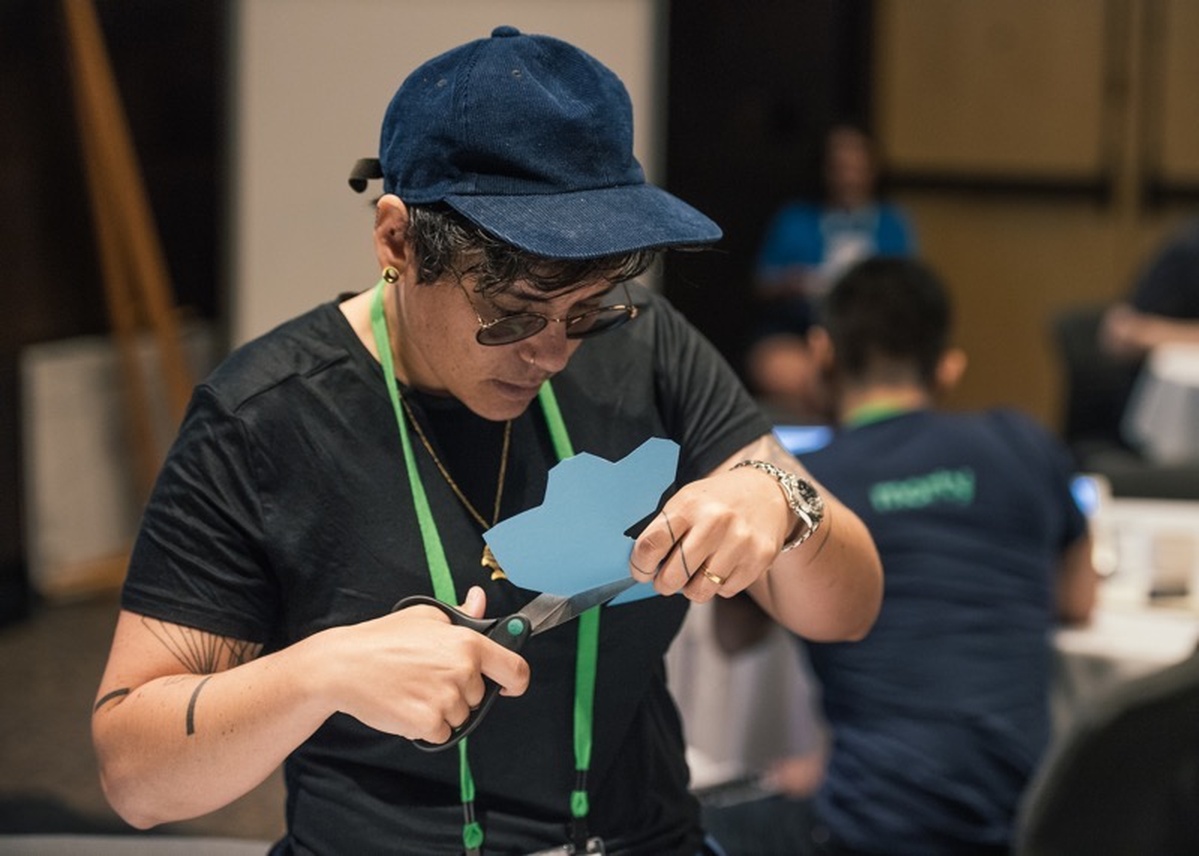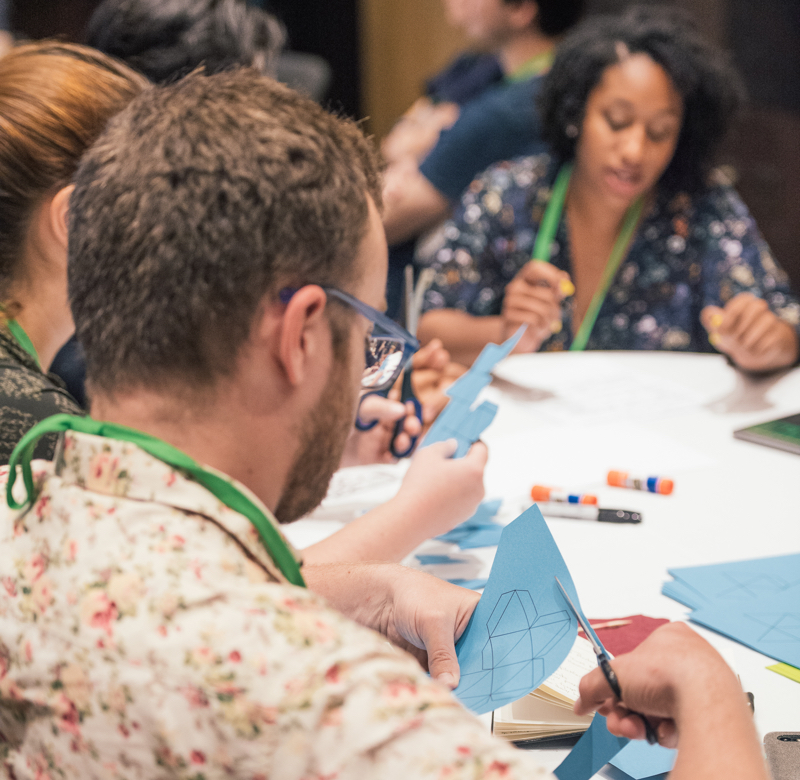Features:
Our Low-Stress Guide to Working Without an Editor
Our best strategies for supporting your work when an editor isn’t around

My co-facilitator Lo Bénichou cutting out a 20-sided die at our SRCCON session. (Photo: Erik Westra)
Working without an editor is difficult. Whether you’re a freelancer, lonely coder, student, new hire, part of a small team, or part of a large team, you may very welll have found yourself in this situation at some point. Even if you “have an editor” it doesn’t always mean that there’s someone able to edit your work and give you the feedback you’re looking for. Maybe you’re the only newsroom developer on your team and you’d like someone to take a look at your code, or maybe you have a great editor who has helped you shape your story, but you’d really like a second opinion on the design choices you made in your piece. These are just a few examples of the various shapes that not-having-an-editor may take.
Lo and I have both worked on teams in newsrooms in the past, so making the shift to Mapbox where we were on a small team of two working without the guidance of an editor was quite the awakening. That said, we knew this problem wasn’t unique to us. Yes, we were experiencing it to the fullest extent now, but we’d also both had past experiences where—even though we may have had someone filling the role of editor on paper—we weren’t able to get the feedback that we wanted and needed.
By the time that we actually started discussing this as a team, we each had come up with a few of our own solutions and coping mechanisms, a few of which turned out to be the same. At SRCCON 2018, we shared what we learned, and also heard about strategies that others have developed for getting work done sans editor.
1) Take time to think on it
Think on your idea overnight, let it ruminate a bit, and come back to it in the morning. Take a break and look at another project for a couple of hours or a day or two. Go for a walk outside or grab coffee with a colleague. Sometimes getting a little distance from the idea at hand can prove helpful and inspire new trains of thought.
2) Don’t be afraid to explore.
Take some time to try out new ideas and experiment with different layouts or display methods. Understandably, this may be difficult if you’re on a deadline, but if you have an extra day or two to play with data and/or mess around with a visualization, you might be able to come up with something even better than what you originally planned. Don’t tie yourself to the first idea you come up with!
3) Talk to other people
Most of the projects that I’ve worked on—that I’m most proud of, that have been the most impactful, and that have turned out the best—either came about through conversations I had with others or were primarily developed through workshopping with others.
The people you’re talking to don’t need to be working on your project or on your team, they just need to be willing to discuss the idea with you. These people will help you figure out what ideas are worth trying, whether that idea has already been tried (and how it turned out), and will (hopefully) become a group of people that you can rely on for articulate feedback.
Talk to you friends in the industry. Talk to your colleagues. Talk to the person who sits next to you at work. Even if they aren’t on the same team or in the same field. Chances are, the user of your product or viewer of your story isn’t going to be a visual journalist, so garnering a variety of perspectives (not just those of visual journalists) could work in your favor.
Also, don’t be afraid to reach out to others online/in Slack! Slack groups have given us all a direct line of communication to communities of folks that would have been much harder to reach in the past—take advantage of it!
4) Ask your audience
Find someone who is a consumer of news, but who doesn’t work in the media industry, to take a look at your project or listen to your pitch. These are the people you’re trying to reach with your story. Finding out what they think early on could prove very helpful and save you from some headache toward the end of the project. Think of it as similar to user testing, but a lot less formal. That said, if you have the desire and bandwidth to [actually] user test your project, go for it!
5) Set a reminder to check in with others
It’s easy to fall into a rabbit hole when working in isolation. Don’t forget to get a gut check from someone on the outside. Having a standing meeting can be great for this. My team holds a weekly meeting on Monday afternoons to check in on current projects and brainstorm new ideas, time permitting. Alternatively, if setting up a weekly meeting feels like too big of an ask, you might consider setting up a weekly Slack reminder to check in with folks:
/remind me to check in with Lo on my project at 1pm PST every Tuesday
6) Find an ally
Maybe it’s an old boss or former colleague. Maybe it’s someone you went to school with or met at a conference. Find someone you trust to critique your work and use that connection to your advantage.
I routinely call upon a small contingent of friends who graduated from the same visual journalism program that I did and whose opinions I value greatly. I also know that they will be honest with me about what is and isn’t working in my project.
Participant Ideas
As part of the session we ran at SRCCON, we asked participants to break into groups and brainstorm their own strategies on how to mitigate the effects of not having an editor. We then asked them to share some of their best ideas with the rest of us.
Ideas were:
Conduct low-fi user testing outside of the newsroom (e.g. with HR, the legal team, or at a coffee shop).
Explain your work out loud to someone. Give them the elevator pitch or radio version rundown of what your project is about.
Prioritize. What is the level of effort you will need to put in to achieve the desired impact? You don’t have an editor to depend on to help you with this, so thinking about this on your own from the get-go might be helpful
Publish your data and write project explainers. This holds you accountable for your work and can be a good way to connect with the journalism community after the project is published.
Think about reciprocity. Requesting feedback can be a big ask. Are there ways that you can give credit to those who help you or find a way to return the favor?
Go to a writers group. This will give you a chance to workshop pieces as a group on a rotation.
Make it easy for people to give helpful feedback. Ask for very specific feedback rather than leaving it open ended. It may make the task feel more approachable and less mentally exhausting. E.g. What’s the best next step I need to take?
Cooking test: make food then invite folks to eat and test your project throughout a night. You may even want to consider separating folks into different groups throughout the evening to test out different things, kind of like lo-fi A/B testing.
Ask for help from friends with visual background but not in journalism.
Check out the various Slack communities and listservs that we have at our disposal: Lonely Coders Club; Journalists of Color (JOC); NewsNerdery; NICAR-L (listserv)
Look into Meetups for local communities
Bring cookies or other food to the office, to lure folks into giving you feedback on your project.
Time management is crucial. Make sure that you have checkpoints spaced throughout the project so that that you don’t run into a huge time crunch at the end.
Make sure to break down the pieces of the project and give time estimates to those working on the project with you in an effort to remain transparent. Since you don’t have an editor helping to relay this information between different folks on the team, it’s helpful to make sure it’s explicitly stated.
Keep an eye on the industry and stay on the lookout for other great data journalism and visual journalism pieces that you might be able to learn from.

Participants brainstorming strategies to get editing help while cutting out 20 sided dice that they could later write the strategies down on. The idea behind the dice: they could be kept at your desk and used to generate an editing idea when you’re feeling a bit isolated and looking for some help. (Photo: Erik Westra)
People
Credits
-
 Casey Miller
Casey Miller
Casey is a data visualization specialist at Mapbox. She enjoys turning data sets into easily understandable, unique, and engaging experiences for users. Before Mapbox, Casey was an engineer at Vox Media in New York where she worked with various editorial teams to tell one-of-a-kind stories across a variety of platforms. Previous to Vox, she worked with teams at the Wall Street Journal, Los Angeles Times, and Atlanta Journal-Constitution.



